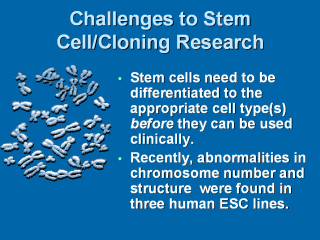| front |1 |2 |3 |4 |5 |6 |7 |8 |9 |10 |11 |12 |13 |14 |15 |16 |17 |18 |19 |20 |21 |22 |23 |24 | 25|26 |27 |28 |29 |30 |31 |32 |33 |34 |35 |36 |37 |38 |39 |40 |41 |42 |43 |44 |45 |46 |47 |48 |review |
 |
In order to be used clinically, human embryonic
stem cells must be differentiated prior to use in patients. Undifferentiated
stem cells could produce tumors and multiply unchecked within a patient,
causing more problems than providing appropriate therapy. It is uncertain if
conditions can be defined such that all embryonic stem cells differentiate
into the correct cell type prior to therapeutic use. Complications caused by
undifferentiated cells might not be discovered until years after the first
clinical trials are begun. This differentiation problem is acknowledged on
the International Society for Stem Cell Research website: "Scientists are still working on developing proper conditions to differentiate embryonic stem cells into specialized cells. As embryonic stem cells grow very fast, scientists must be very careful in fully differentiating them into specialized cells. Otherwise, any remaining embryonic stem cells can grow uncontrolled and form tumors." ¹ Recently, three established stem cell lines were shown to exhibit abnormalities in chromosome number and structure.² ³ Obviously, stem cell lines must be checked periodically to make sure the cells do not become abnormal during continued culture. The use of abnormal cells in treatment of patients could result in indeterminate complications. References ¹ "Frequently Asked Questions." International Society for Stem Cell Research. ² Draper, J.S., et al., "Recurrent gain of chromosomes 17q and 12 in cultured human embryonic stem cells," Nature Biotechnology December 7, 2003, advance online publication. ³ C. Cowan et al. 2004. Derivation of Embryonic Stem-Cell Lines from Human Blastocysts. New England Journal of Medicine 350: 1353-1356. |